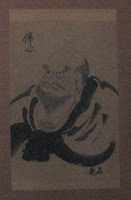 Today we finished sesshin (literally, “gathering the heart”), a Zen-style retreat with 13 forty-minute sittings, formal meals, service, etc. I’ve been doing this practice pretty regularly, usually monthly, for over 30 years. My oh my (pat on the back). I think of Leonard Cohen’s line “Death is old but its always new.” So too sesshin. Now I sit with a small group and sometimes alone. After 30 years, I can heartily say, sesshin is a wonderful lifestyle. Here’s a few other reflections so as to include you, blog reader, in the gathering.
Today we finished sesshin (literally, “gathering the heart”), a Zen-style retreat with 13 forty-minute sittings, formal meals, service, etc. I’ve been doing this practice pretty regularly, usually monthly, for over 30 years. My oh my (pat on the back). I think of Leonard Cohen’s line “Death is old but its always new.” So too sesshin. Now I sit with a small group and sometimes alone. After 30 years, I can heartily say, sesshin is a wonderful lifestyle. Here’s a few other reflections so as to include you, blog reader, in the gathering.
1. We begin each sesshin with the Full Moon Ceremony. It includes the Formless Atonement, Ten Names of Buddha, Great Vows, Dogen’s Words on the Precepts, and the Refuges. It seems to me now that Formless Atonement is more about how to practice now than wiping the slate clean of any past wrongdoings. The karma from those actions may well appear as a big dog that bites us on the butt no matter how devotedly we pray. The Atonement verse teaches us how to meet the dog.
“All my past and harmful karma
born from beginningless greed, hate, and delusion
through body, speech, and mind
I now fully avow.”
Avowing, taking full responsibility, comes with a clear, open heart. Shame, blame, and denial all arise from various types of disturbed mind – we include them in the circle of the Way, for sure, and they have their own virtuous qualities. However, shame, blame, and denial are distinct from taking responsibility.
2. Bodhidharma (see above photo from TransformingThroughPlayTemple’s zendo) looks like one rough guy, doesn’t he? However, he comes with the gentle characters “Buddha Heart” in the upper left. I heard recently that his teacher, Prajnatara, may have been a woman. According to unreliable Zen lore, Bodhidharma came to China fifteen hundred years ago and was uncompromising with Emperor Wu and later with his small rag-tag band of students (including Wu’s daughter, Zongchi). See Sallie Tisdale’s Woman of the Way for a compelling retelling of the story from Zongchi’s perspective.
From any perspective, Bodhidharma’s circumstances and our circumstances are different. Still … his reputed unwavering authenticity inspires me still – even sometimes on the second day of sesshin (the hardest part of the journey according to unreliable Zen lore) when most of grosser forms of bullshit have burned away.
3. “The hardest part” ain’t as hard as it used to be. Usually, not hard at all (knock on wood). Yet, it seems to take most of us many years of practice to settle and soften. Despite my notions of specialness, apparent breakthroughs, and periods of utter bliss, probably took ten years of frequent sesshin for me to settle somewhat and twenty more to soften a little. From this experience, I don’t believe in spiritual shortcuts – although I still keep my eye out for them just in case. Paths I found along the way that I thought were shortcuts, almost always went the wrong way.
But hold up, some gross forms of bullshit have slipped back in already! What’s this about “wrong ways?” They too are an important part of the so-called Buddha Way. Wu-men’s first two cautions come to mind. “To maintain standards and follow rules is to tie yourself up without a rope.” AND “To indulge freely without restraint to to behave like heretics and demons.”
And while I’m into self critique, I would also like to challenge the blogger’s blather about ten-years, twenty-years, thirty-years. It is ridiculous, afterall. Every step of the way has been wonderful, especially through the dark. Especially from the perspective of a little light.
4. Finally, speaking of light, a summer recipe tip that we enjoyed during sesshin: for a delicious cool soup, see The Splendid Table’s cucumber soup: (http://www.elabs7.com/functions/message_view.html?mid=8137&mlid;=499&siteid;=20130&uid;=0f14583ac1.
Comments, questions, and contrary expressions are welcome.











